Netaji Subhas Chandra Bose: After-1945
This is a collection of articles archived for the excellence of their content. |
Contents |
1942, 1944: Rumours of crash
The Times of India, Sep 19 2015
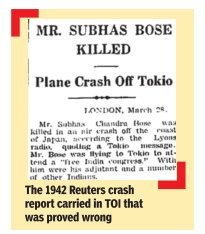
Multiple rumours of crash between 1942 & 1944
Jhimli Mukherjee Pandey Was Netaji's “death“ in the Taihoku air crash the culmination of a rash of crash theories that started appearing 1942 onwards? Intelligence files declassified on Friday indicate that rumours on the leader's death in air accidents appeared multiple times between 1942 and 1944 till the “final crash“ on August 18, 1945. The first file suggests that in March 1942, Netaji had died in a Japan plane crash. Subsequently , on June 6, 1942, an intelligence agent (TL 103) reported that the Madaripur Jugantar Party had used a “transmitting set“ to talk directly with Subhas in Bangkok after reports of that air accident began doing the rounds. They were much relieved to know Netaji was doing fine. Entries in this file provide details of special transmitters used to catch “enemy broadcasts“ from Axis radio streamed mainly from Berlin, Saigon, Tokyo and Bangkok. They suggest Netaji might have been in Bangkok then for the Indian Independence Conference.
A May 17 entry marked “secret“, says: “It is reported from Bangkok that in view of the sudden collapse of the British forces in Burma, leaders of several organisations in East Asia fighting for India's freedom will soon hold a conference in Bangkok.“
Another entry zeroes in on a Netaji aide, Jathedar Mohan Singh, in Kolkata who used to derive a lot of information on Netaji from Axis Radio. The entry reads thus: “Singh's reference to the prospective attendance of Bose at the conference is based on the in ference that the Indian National Council (under whose auspices the Bangkok conference was to be held) had been formed under Subhas Bose's guidance and inspiration.“ The entry mentions the rumour that Netaji had left Europe for the Far East. It warns that Singh might have been getting his information through “other channels“ and that “remains a live issue“.
The file is replete with entries about wireless transmissions and about wireless transmissions and secret codes created to receive Axis transmissions. The files repeatedly mention Jatin Bhattacharjee in this context. His notebook and transmitter were seized for the codes he had recorded. These were decoded by police radio experts later who concluded that a parallel “channel of communication“ existed between India and “enemy-occupied“ countries.
An entry by W Mack Wright, I P (equivalent of IPS), on July 17, 1942, reads: “Hindusthan Standard (A Kolkata newspaper no longer in circulation) discredited the news of the death of Subhas Chandra Bose in an air crash. In the editorial column of its issue of Monday March 30, 1942 that appeared in heavy print, the following notice appeared: `Reuter' announces the death of Sri Subhas Chandra on information gathered from Lyons and Vichy Radios. We refuse to write an obituary notice. Long Live Sri Subhas Chandra!“ In a much later entry in file 64, the fact that Netaji's family quashed the theory of yet another air crash on October 23, 1944, has been mentioned. Netaji's nephew, Sisir Bose, was recorded to have been questioning the purported crash at Taipei, Formosa on that day. The entry mentions that Sisir Bose asked Yotori Yo Ko Bori of the Kyode News Service, Tokyo, to investigate if any crash had happened that day at all.
1949: Blitz dismissed death-in-crash theory
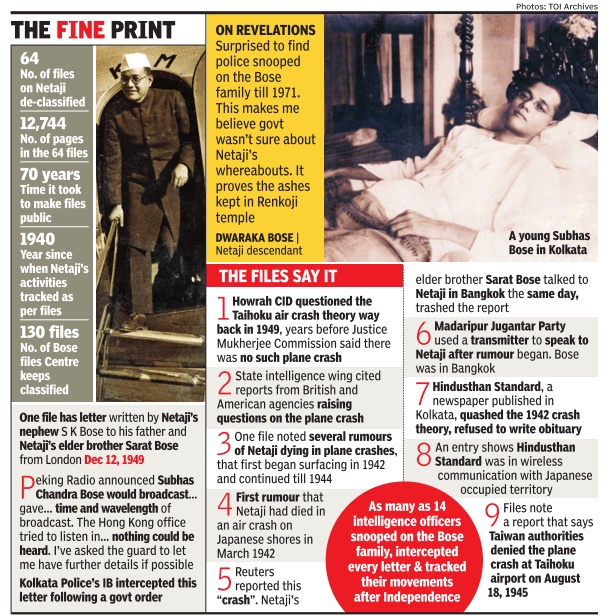
The Times of India, September 19, 2015
Blitz report junked crash theory in 1949
In April 1949, more than 50 years before the Justice Mukherjee Commission concluded that Netaji did not die in the Taihoku crash, a state intelligence officer had forwarded a report to his superior that doubted the authenticity of the accident. The report, published in the popular tabloid Blitz on March 26, 1949, referred to concerns in the British government over confidential information about Netaji. It said he was alive and waiting to return to his homeland. This is part of the files declassified on Friday.
“This sensational news, upsetting the wishful thinking of many who believed that Bose died in a crash, was originally transmitted to the British Foreign Office from the British Embassy in Turkey and is reported to have been confirmed since from Anglo-American secret agents in the East,“ reads a copy of the report sent to the police superintendent, District Intelligence Branch (DIB), Howrah, on April 29, 1949, by DIB-CID. Copies were forwarded to the SSP (II) IB, CID, Kolkata and SPs of DIBs in Cooch Behar, West Dinajpur, Malda, Nadia and Murshidabad.
“It is not known whether news of the Living Bose is based upon positive evidence of his whereabouts, suspected to be in Red China or Soviet Russia, or upon what is described as the `negative' evidence of the failure of the best brains of the Anglo-American security services to dig up the slightest evidence confirming the story of Bose's death in a plane crash and his subsequent cremation with full military honours in Tokyo,“ the report states.
The plane crash theory was based on a statement by General Habib-ur-Rahman, chief of Netaji's personal staff, who claimed that he was with Bose in the plane when it crashed. There were inconsisten cies in his statement that led to doubts over what happened. Rahman later claimed that Netaji was alive and would return. “ Anglo American sources, haunted by the bogey of the Red Peril, seem to see the hand of Bose behind every Communist offensive in South-East Asia and the Far East. They seem to have decided that the Indian leader is undergoing training in Russia to emerge as another Tito, Dimitrov or Mao when the Marxist hour strikes for India,“ the Blitz said.
Two decades after this report was cir culated before being archived, MP Samar Guha wrote to then state chief secretary M M Basu, bringing to his notice a report in a lo cal daily that quoted a former war veteran as saying Netaji boarded a Japanese submarine in Singapore instead of the fatal flight. The informer also claimed Netaji had left his sword with him, which he brought to India with the help of late Air Marshal Subrato Mukherji. “This report, if true, throws a whole new light on Netaji's escape from Singapore. I hope you will consider the matter as very important and make an inquiry ,“ Guha wrote on March 11, 1969.
1949: Radio message promises Netaji’s voice, falsely
The Times of India, Sep 19 2015
Rakhi Chakrabarty
Radio messages that raised hope of Bose brigade
Two years after independence, a radio broadcast aroused much curiosity and stoked the hope of many Indians that Netaji could be alive. A letter one of Netaji's nephews, Amiya Nath Bose, wrote to brother, Sisir Kumar Bose, said: “For the last one month, a strange broadcast is being heard over the radio.We're getting this broadcast on the short-wave near 16mm.The broadcast only says, “Neta Subhas Chandra Bose transmitter-e katha bolte cheyechhen. (Bose wants to speak on the transmitter).“ This sentence is repeated for hours.“
The letter dated November 18, 1949 was intercepted by the Kolkata Police Special Branch.Sisir was then studying medicine in London. Elder brother Amiya lived in Kolkata.
Amiya continues: “We don't know where it (the broadcast) is coming from, because that's not announced.It's possible to find the location of a transmission.“
This letter figures in File 606-29, one of 64 declassified by the West Bengal on September 18, 2015.
The disappearance of Netaji
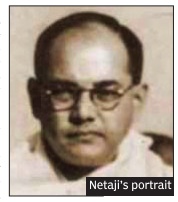
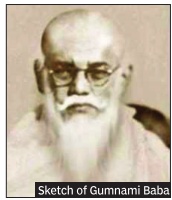
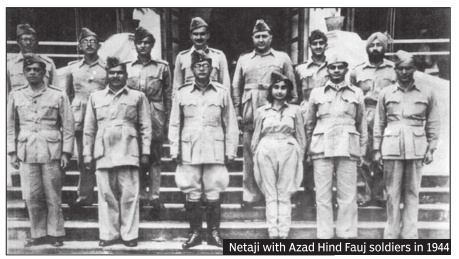
The Times of India, Sep 07 2015
It's one of the greatest mysteries of modern india: was gumnami baba, also known as the ascetic of up's faizabad, actually netaji subhas chandra bose? subhro niyogi, saikat ray and a team of reporters track down some people who actually interacted with him and are convinced that it was none other than the charismatic leader himself, living under an assumed identity. read on to find out what they have to say
A moment that lasted a fraction of a second 33 years ago is etched so vividly in Sura jit Dasgupta's memory that a mere recollection triggers a myriad emotions. Dasgupta's facial muscles twitch, lips quiver and eyes turn misty as he strives to utter something, stutters and then gives up. After several minutes of internal strife, Dasgupta composes himself. “He was seated before me like every day when I had an urge to see him. I stole a glance and was so dazzled by the glow that emanated from within that I had to immediately lower my gaze. It is a sight I will never forget,“ he mumbles.
The “he“ Dasgupta refers to was Bhagwanji, an ascetic in Faizabad, UP , who very few “knew“ to be Netaji Subhas Chandra Bose. Here was the man who had been pronounced dead 37 years ago, a death millions refused to believe. Many felt he would return to India one day to finally solve one of the most baffling mysteries of modern times. And there he was! “Netaji's associate and our guru, Sunil Gupta, had been visiting Bhagwanji for two decades. In the initial years, it was very secretive. He wouldn't disclose where he was going. All that we knew was that he had some very important mission. Later, he cryptically said: `Contact has been established'. I knew at once he was referring to Netaji. I was thrilled. In the years that followed, I would accompany Gupta till the station as he took a train twice a year to travel to Neemsar and later Faizabad, once during Durga Puja and again on January 23, Netaji's birthday . It was much later, in 1982, that Gupta decided it was finally time we could be let into the exclusive circle, and we travelled to Faizabad to meet Bhagwanji,“ Dasgupta recalls.
It was Netaji's elder brother, Suresh Chandra Bose, who had tasked Gupta with exploring every news and rumour that surfaced on Netaji's return to India. Gupta faithfully went to Shaulmari and other places where it was rumoured Netaji had returned in the guise of an ascetic. He was disappointed on each occasion, till he finally met Bhagwanji at Neemsar in 1962.
A few ground rules were laid before Dasgupta's first meeting; the most important being not to look at Bhagwanji. He generally communicated with a short curtain drawn between him and the visitors that hid his face. That is how Dasgupta met him as well.
“We would go to his house every day , have breakfast and then go to shop for the day's meals. While Saraswati Devi would cook, we would discuss world politics.After lunch, it could be about theology , music, even metaphysics. Sometimes, the discussions went on till the wee hours next morning. We would sit transfixed, listen with rapt attention and take down notes.He predicted the disintegration of USSR that was unthinkable then, talked about the mess in the Vietnam War. He even remarked that communism would die in the place of its birth. During the Bangladesh Liberation War, he followed the developments keenly and we believe he even passed on strategic instructions that helped decide the war,“ Dasgupta says.
After the first two-three days, Bhagwanji trusted that the youths would follow the rules, and stopped drawing the curtain. It was on one of these days Dasgupta was seized by the irresistible desire to steal a glance at the person hero-worshipped across Bengal. And what a sight it was! “There was no mistaking it was Netaji. His hair had thinned, much more than what we were used to seeing in his photographs. He had a flowing beard. But the features were exactly the same. Only , he had aged. The eyes were so powerful I had to turn away immediately . I realized then that the patriot our parents and we had worshipped since we were kids had reached a higher plane of existence. He had become a mahatma,“ he recalls.
Rita Banerjee of Faizabad, too, refers to a “bright light“ emanating from Bhagwanji. “The aura was so intense that I could not establish eye contact with him,“ says Rita, whom Bhagwanji called “Phoolwa Rani“ and her husband “Bachha“. Gyani Gurjeet Singh Khalsa, the chief priest of Gurdwara Brahamakund Sahib that overlooks the raging Saryu river, recounts a similar experience when he saw Bhagwanji face-to-face. “I was a 17-year-old when I saw him. The radiance on his face was astounding. It cannot be explained in words,“ he recounts.
Dasgupta, who is now 64, and some others who are convinced that Bhagwanji was Netaji, are waging a silent legal battle against the Indian government to extract the truth and discredit a lie they claim has been propagated for seven decades. In later years, Bhagwanji talked about the escape to USSR via Diren in Manchuria after a “concocted air crash“. He talked vividly about how prison camps functioned in Siberia.
Dasgupta is among the very few alive to have met Bhagwanji. Bijoy Nag, a former auditor at a private firm, is another. Though he never looked at Bhagwanji, he can recall each meeting with amazing clarity . “On my first visit, I touched his feet while he remained behind a curtain. Blessing me, he said: `Your dream is now a reality'. I was 31 and thrilled,“ recalls Nag, now 76. In all, he had met the ascetic 14 times between 1970 and 1985, and each meeting was memorable.
Most of Dasgupta's visits were when the ascetic was living in Purani Bustee.But it was at Brahma Kund (Ayodhya) where Bhagwanji stayed for a few months between 1975 and 1976 that Nag was in closest proximity with him. “I stayed in the room next to his. I could have looked at him any time if I wished because by then, the curtain had been drawn.He had only instructed us not to look at him and we didn't disobey him,“ says Nag, who had on Bhagwanji's request collected and delivered photographs of Netaji's mother, father and school teacher.
More stoic than Dasgupta, Nag is in control of his emotions but there is no mistaking the glimmer in his eyes when the subject is discussed. “Though I didn't look at him, I don't have an iota of doubt it was Netaji speaking to me. It is an unshakeable truth,“ he says with such definitiveness that one realizes it is backed by absolute conviction.
It was because of his aunt Lila Roy -who had been in constant touch with Netaji between 1922 and January 1941 -that Nag got the opportunity to meet Bhagwanji. It was Sketch of INA secret service agent Pabitra Mohan Roy who told Lila about Bhagwanji in December 1962 after another Netaji associate, Atul Sen, broke the news on his return from Neemsar. His meeting Bhagwanji had been sheer providence. Sen, who had contested the legislative seat from Dhaka in the 1930s on Netaji's insistence and won, was in 1962 travelling to various places in UP on “change“ on doctor's advice.
In April, he reached Neemsar, a pilgrimage site near Lucknow. It is here that he heard from locals about a Bengali mahatma who lived in an abandoned Shiva temple. Sen's curiosity was piqued and d went to meet the ascetic. He finally met d him after several attempts -and instant ly knew it was Netaji. Over the next few n days, he met Bhagwanji many times.
. An ecstatic but cautious Atul Sen re) turned to Kolkata in 1962 and disclosed s the news to Pabitra Mohan Roy and his torian RC Majumdar. Sen also wrote to e PM Jawaharlal Nehru on August 28, 1962.
“Netaji is alive and is engaged in spiritual e practice somewhere in India... From the talks I had with him, I could understand that he is yet regarded as enemy No. 1 of Allied powers and that there is a secret protocol that binds the Indian government to deliver him to Allied `justice' if found alive. If you can assure me otherwise, I may try to persuade him to return to open life,“ he wrote. In the reply dated August 31, 1962, Nehru denied the existence of any such protocol.
Lila, meanwhile, resolved to serve Bhagwanji till her last day. From 1963 till her death in 1970, she would send money and sundry items to him every month through emissaries. Bhagwanji was fond of typical Bengali dishes like ghonto, sukto and keema. During his birthday celebrations, a closed-door affair with some family members and close acquaintances, delicacies served included mishti doi and khejur gur payesh.
It wasn't just people from Bengal who were meeting Bhagwanji. From December 1954 to April 1957, UP CMs Sampurnanand and Benarasi Dasgupta were in constant touch with Bhagwanji.Their letters as well as those from former railway minister Ghani Khan Chowdhury and other important leaders were found in Bhagwanji's belongings that are now in Faizabad Treasury .
The Gumnami Baba of Faizabad?
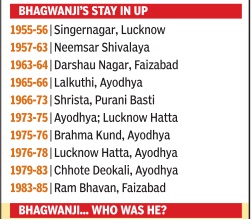
Was Bhagwanji the same as Netaji?
The Times of India, Sep 07 2015
One of the reasons why followers of Bhagwanji are convinced he was Netaji is the uncanny knowledge of minute details about brief encounters Netaji had with them before the Great Escape from his Elgin Road residence on January 16, 1941. The most startling among them was things he would say to emissaries through whom Lila Roy sent money and sundry items every month till her death in 1970 h Since Bhagwanji kept shifting from one place to another, he would send coded messages to let emissaries know when he was in a dera. The emissaries would then carry a brief note that Lila Roy wrote about them to assuage Bhagwanji's apprehensions about their trustworthiness h There are many anecdotes that emissaries believed were clinching proof that Bhagwanji was Netaji. In a note on one Apurba Ghosh, it was mentioned that he was in the reception committee at Manikganj. In the deposition before the Justice Mukherjee Commission, he recounted the interaction between him and Bhagwanji. “He asked me whether I was the man who offered him a comb when he came out of the bathroom in Kutcharibari after having his bath. When I said yes, he asked me whether I had noticed him smiling. He said he had smiled because instead of offering the comb on a plate or dish, I had offered it with my bare hands. He also enquired about Bahadur, the durwan at the Bose residence on Elgin Road. He then asked me if I had seen the calendar with a picture of Goddess Kali in Netaji's living room. I had seen it there. These are things that only Netaji himself would have known,“ Ghosh told the commission.
On the Gumnami trail
The Times of India, Sep 08 2015
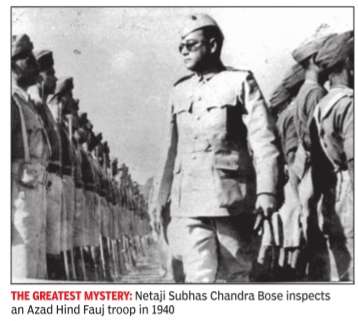
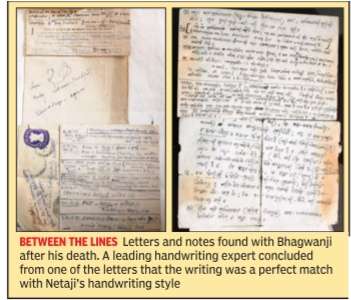
The Justice Mukherjee Commission concluded that Netaji didn't die in the Taihoku air crash. And there is a recent court order to inquire into the identity of Gumnami Baba. Subhro Niyogi & Saikat Ray trace the ascetic's journey over three decades and come up with some startling facts It is one of the most enduring mysteries of modern day India, one that has baffled three generations of truth-seekers. And it continues for over 68 years with political leaders, bureaucrats, diplomats, and agencies trying to establish that Netaji Subhas Chandra Bose died in the Taihoku plane crash in Taiwan on August 18, 1945 -which the Justice Mukherjee Commission, set up to investigate the theory , categorically dismissed. Recently , the Uttar Pradesh government decided to set up a museum at Faizabad to preserve the articles used by an ascetic who bore a striking resemblance to Netaji. This is the first initiative at the government level following an order of the Allahabad HC in January 2013 giving credence to the findings of the Mukherjee panel, which held after a seven-year inquiry into Bose's whereabouts post-August 18, 1945 that Netaji didn't die in the plane crash. Mukherjee concluded that there was no such incident in Taiwan that day . He also stated that the ash preserved at the Renkoji Temple in Tokyo were those of a Japanese, Ichiro Okura, who had been cremated.
Incidentally , even Mahatma Gandhi had not bought the plane crash theory . In January 1946, he asserted his belief that Netaji was alive and would appear at the right moment. A week before the naval mutiny , Gandhi insisted on speaking about Netaji in the present tense. According to some, Nehru was said to have received a letter from Bose saying he was in Russia and wanted to escape to India. He would arrive via Chitral, where one of Sarat Bose's sons would receive him.
The Lucknow Bench of Al lahabad HC didn't stop at asking the UP government to scientifically preserve the articles in a museum. It directed the government to set up a committee of experts under a retired HC judge to hold an inquiry on the identity of the late Gumnami Baba, the ascetic from Faizabad who was cremated on August 18, 1985.
In essence, the order takes the findings of the Mukherjee panel forward. Mukherjee, in his report, hinted at the striking resemblance between Netaji before 1945 and Bhagwanji or Gumnami Baba. “ Apparently there is no reason for not acting or relying upon the evidence of witnesses, particularly those who had seen Netaji before 1945 and also met Bhagwanji or Gumnami Baba face to face, more so when their evidence regarding the frequent visits of some freedom fighters and some politicians and former members of INA on January 23 and during the Durga Puja is supported by the fact that letters written by them...were found in Rambhavan, Faizabad...“ the report says.
According to Gyani Gurjeet Singh Khalsa, chief priest of Gurudwara Brahamakund Sahib where Bhagwanji had lived for six months before moving to Ram Bhawan, Army and cops as well as officials from the administration would clandestinely meet Bhagwanji in the cover of darkness, generally after 11pm. “They all came in black Ambassador cars,“ he recounts.
On September 7, 1963, Lila Roy sent a letter to Netaji's close friend Dilip Roy on Bhagwanji's instruction. “I wanted to tell you something about your friend. He is alive; in India,“ she wrote. Roy's death in 1970 was a big blow to Bhagwanji and he admitted so in a letter written to pay homage to her. Leading handwriting expert B Lal, who compared the handwriting of this letter with Netaji's writings, said they were an exact match.
The reclusive and mysterious ascetic, who later came to be known as Bhagwanji and later still as Gumnami Baba, arrived at Shringar Nagar in Lucknow's Alam Bagh area in 1955, barely two years after Stalin's death.
Bhagwanji lived in a rented house in Shringar Nagar for two years in relative anonymity before moving to Neemsar, near the Indo-Nepal border, in 1957. It was only in April 1962 that Atul Sen, an associate of Netaji, met and recognized the ascetic.Thereafter, many people from Bengal began visiting him, particularly during Durga Puja and on January 23, Netaji's birthday. It took years for the ascetic, who was always on his guard and behind a curtain, to open up. But he remained wary, frequently changing his lodgings.
The fears weren't unfound ed, say Netaji loyalists. They cite documents referred to in the `Transfer of Power, Vol-VI' that clearly establishes that the British government knew of the existence of Netaji after August 18, 1945. A top secret letter of Sr F Mudie, home member, viceroy's executive council, to Sur E Jenkins dated August 23, 1945, revealed that five days after the alleged air crash, they were thinking of taking a decision on the treatment of Bose as a war criminal and the consequences they may have to confront.
Many of those who had met Bhagwanji during this period have no doubt that it was Netaji. Though most of them are no longer alive, their emphatic deposition before the Mukherjee Commission is proof of their conviction.
On September 17, 1985, it was declared that Bhagwanji had died of a cardiovascular failure at 9.45pm the previous day . On September 18, the doctor certified the death. On September 19, a bier-like structure was cremated at Guptar Ghat on the bank of the river Saryu, Faizabad, at 4pm. No one was allowed to see his face. Physician P Banerjee, who was present at the cremation, later disclosed that it was not Bhagwanji whose body was consigned to flames.
There is another mystery .A matchbox containing seven teeth, assumed to be those of Bhagwanji, was sent for DNA tests to the Central Forensic Science Laboratory in Kolkata and to a Hyderabad-based lab.The latter's report was inconclusive. The former gave a negative report. But Netaji researcher Anuj Dhar questions the very authenticity of the report and points to a “scoop“ in a local daily that reported the finding six months before the report was signed and sent by the CFSL director to the Mukherjee panel.
“For some reason the expert who supervised the DNA tests was not willing to appear before the commission.He did so only after repeated summons,“ Dhar says.
While Dhar is perturbed by the UP government's silence on the inquiry the HC judges had stated in their order, he is glad that a museum is finally under way to scientifically preserve the ascetic's contents for re-examination. In their observation on a case (No. 929 of 1986) filed by Netaji's niece Lalita Bose, Justice Devi Prasad Singh and Justice Virendra Kumar Dixit observed that during the search of Bhagwanji's house, “a large number of belongings and literature associated with the INA in general and Subhas Chandra Bose in particular came to light. There were a large number of family photographs, reports of inquiry commission related to the death of Netaji etc. It also transpired that a special ceremony used to be held in the room of Bhagwanji each January 23 which, incidentally , is the birthday of Subhas Chandra Bose and that on that day , no person from Faizabad was allowed to visit him. Some persons from Kolkata used to come and stay with him for that day“.
Surviving a smear campaign
The Times of India, Sep 11 2015
Kingshuk Nag
Siberian survivor to secretive sadhu... Netaji mystery lives on
How the legend of Subhas Chandra Bose survived smear campaigns
Late in June 1993, Ajai Malhotra, then information counsellor at the Indian Embassy in Moscow, was despatched by the ambassador to the offices of the bi-monthly Asia and Africa Today to investigate whether the magazine was proposing to run a story alleging that Netaji Subhas Chandra Bose was an agent of the MI-6, the external arm of British intelligence. The deputy chief editor, V K Tourdjev , said that they indeed were and said that the story was based on information ferreted from KGB archives. He also showed Malhotra, from a distance, a letter marked `top secret' and written by Colonel G A Hill of British intelligence on 11 December, 1943, to Colonel Osipov of Soviet intelligence that alleged that Bose had “cooperated“ with the MI-6. It also alleged that Bose had escaped to Kabul from house arrest in Calcutta with the full knowledge of the British intelligence.
By mid-1943, Subhas Bose was already in Singapore and had launched the Indian National Army with the cooperation of the Japanese.He was fighting the British, who were keen to get rid of the Indian patriot by hook or crook, tooth and nail.
In fact, the Special Operations Executive (SOE) -an irregular war-time sabotage agency set up at the instance of British PM Winston Churchill -had been ordered soon after Bose disappeared from Calcutta to “eliminate“ him, including by assassination. The SOE's branch office in Istanbul had been conveyed this direction, because the British intelligence expected Bose to move into Europe through Turkey . In the event, Subhas Bose travelled to Berlin via Soviet Russia, foiling the British attempt.
Meanwhile, British intelligence was also picking information that Bose could be interested in tying up with the USSR to liberate India. That is how the grand conspiracy was launched: portray Bose as a British agent and sow suspicions in the mind of the Soviets. This would serve the British purpose, if Bose hitchhiked with the Soviets. The Soviets would not be able to fathom that a patriot like him -who spent a whole life fighting the British -could even think of cooperating with them, much less be their agent.
As Netaji's bad luck would be, he broke into Soviet-occupied territory at the end of the World War after faking an air-crash in Taipei (the Justice Mukherjee Commission conclusively proved that no air crash took place). Subhas Bose believed that with the end of the War, it was only the Soviet Union with its antiimperialist credentials that could help to deliver India from the British yoke.Though he landed in Dairen in Manchuria (now Dallian in China), Bose's plan was to go to Omsk in Siberia.
During the War, a large part of the Soviet administration had shifted to Omsk because it was away from the German borders. Bose had himself sent his representative Kato Kochu (an assumed name of an Indian whose identity is yet to be established) to set up a mission of the Provisional government of Azad Hind.
What happened in Omsk is not known in precise detail but Subhas Bose fell to British misinformation.The Soviets had a bad track record of dealing with people they thought had doubt ful intentions and Bose was not their only victim.
Raoul Wallenberg, Swedish diplomat in war-time Budapest -controlled by the Third Reich -played a yeoman's role in saving the lives of hundreds of Jews by giving them Swedish documents. But when the USSR invaded Hungary , one of the first things they did was to gaol Wallenberg on charges of being an American spy . In World War II, the US and the Soviets fought on the same side but this did not deter them from acting against each other.Wallenberg never emerged from behind the Iron Curtain.
Bose possibly fell a similar victim although evidence has been seen by Russian researchers in KGB archives that in October 1946, Stalin was discussing with his foreign minister Molotov how to do deal with Bose. Analysts think Stalin, who had very rudimentary knowledge about India and thought very poorly of Indian leaders, including Mahatma Gandhi (on whose death he refused to send a condolence message), was persuaded by the British misinformation to despatch Netaji to the Gulag, at least for some time. That Netaji had no lobby in Kremlin working for him meant that his case went unrepresented. But he might have been kept alive because this was a necessity .
Stalin's relations with the new India were frosty and the Commissar felt that the newly independent country would become a proxy of the British and America in the emerging Cold War scenario.He may have decided to keep Netaji alive because a section of Soviet intelligence had indicated that he, rather than Gandhi and Nehru, was the right person for the Soviets to work with in India.
At what point Subhas Bose was released and how he reached India incognito is something that is yet to be unravelled. But when holy man Gumnami Baba died on September 16, 1985, in Faizabad, the story began to circulate that Netaji Subhas Bose has died. “I also heard the story and decided to investigate,“ says then college professor and journalist V N Arora. But this became a little difficult because the caretakers of the Baba had locked up his premises, putting multiple seals. “A few prominent local citizens like us then represented to the district magistrate to open the premises for us to investigate who this Baba was,“ Arora told TOI.
Taken in by the strong representation, the DM agreed and allowed Arora and others to inspect the premises for half an hour. “In the end, we came out after eight hours.There were an astounding range of books and documents pertaining to Netaji, including the dissent report of Suresh Chandra Bose (Netaji's elder brother) to the Shah Nawaz Committee that asserted that the patriot had died in the air crash. There was also the report of Radha Binod Pal who had dissented from the International Tribunal on whose report Japanese bigwigs, like H Tojo, the Japanese PM, were sent to the gallows. There were also books on contemporary politics and the original photograph of the Baba -the copy that had been released by Parliamentarian Samar Guha in the late 1970s to a newspaper, claiming that Netaji was in hiding.There were newspapers from 1964, with comments of the Baba on the side. All the stuff was later stored in the Faizabad district treasury where it still remains.
Arora did more research on who the Baba was and came across a man who, though he remained behind curtains, was perennially experimenting. For instance, he deliberately stayed in a house that had no electricity connections for six months. Yet, at the same time, the Baba only ate organically grown food and this was organized for him by Panda Ram Kishore, a leading tirth purohit of Ayodhya.
The Panda -whom Gumnami Baba used to call Nand baba -is now dead but Arora recollects a story told by him.“It was night in the dead of the winter and Gumnami Baba was sleeping in the room. Ram Kishore was sleeping outside with an angeethi to warm him. Suddenly , Ram Kishore realized that the Baba could be feeling cold. So he hastened inside to ask the Baba if he needed the angeethi. Baba replied: this body has lived in Siberia. It does not require warmth,“ Arora remembers Ram Kishore having told him.
His last stop
The Times of India, Sep 08 2015

Located on the busy Faiza bad-Ayodhya Road and close to the circuit house, Ram Bhawan, over the past few decades, has become a household name not only among residents of Faizabad, but also for millions of Netaji fans who view it as a temple that housed their idol and one of India's most valiant sons in exile, for almost three years. This was Bhagwanji's last stop, where he lived from November 1983 till his death on September 16, 1985. Recollecting the days spent with the ascetic whom he called Gumnami Baba, Thakur Shakti Singh says: “It was around mid-1983 that my father was asked by Dr RP Mishra, a surgeon at the district hospital, to rent out to him the small quarter at the back, which has a separate entry. He said it was for his `dada' who wanted peace and quiet for his spiritual practice, which he cannot get at home.“
Initially reluctant, Singh finally agreed to rent the room to the ascetic. After moving in, Gumnami Baba had a very strict policy on meeting visitors. He met very few people and only during late evening hours after he had finished his `sadhana'.The fortunate few who got to meet Bhagwanji were convinced he had special powers. “Once a person entered Ram Bhawan, he would be completely overwhelmed by Gumnami Baba's presence. The only person who had full access round-the-clock was his caregiver, the late Saraswati Devi Shukla, whom Baba used to call `Jagdambe'.“
Lalita Bose, Netaji's niece, visited Ram Bhawan in February 1986 after Bhagwanji's death. As soon as she saw the items in his room, she began to weep and said they belonged to Netaji. Later she urged the district magistrate to intervene, and even met then UP CM Veer Bahadur Singh. The latter suggested she move court. After the matter was brought to the notice of the court, the district administration was asked to shift 2,760 articles kept in Bhagwanji's room to the district treasury in as many as 25 trunks.
After Bhagwanji's death, an idea struck Singh. He used to see children playing around the room where Bhagwanji lived.“I called the children and asked them to describe the person who used to stay there. I also hired an artist to make the sketch on the basis of the children's description. When the artist turned the canvas towards us, we were astounded by the similarities between the sketch of Gumnami Baba and Netaji Subhash Chandra Bose as he appeared in photographs,“ recalls Singh.
The Bose probes
The Times of India, Apr 12 2015
The Bose probes
Days after the Taihoku crash, rumours on whether Netaji had survived it began. Several panels have probed the matter
Figgess Report 1946
Found Bose died in Taihoku Military Hospital on Aug 18, 1945. Cause of death heart failure resulting from multiple burns and shock in crash near Taihoku airport. Cremated in Taihoku & ashes transferred to Tokyo
Shah Nawaz panel 1956
Khan was in the INA and the best-known defendant in the INA trials. Two members concluded Bose died in crash.Bose's brother Suresh declined to sign final report, wrote dissenting note saying the two withheld crucial evidence from him, that Nehru directed committee to infer death in crash
Khosla panel 1970
Retd CJ of Punjab HC GD Khosla tasked to probe Bose's “disappearance“ Concurred with reports, suggested political motives behind those denying crash
Mukherjee panel 1999-2005
Following a court order, SC judge MK Mukherjee headed team to probe death. Concluded there was secret plan to ensure Bose's safe passage to USSR with knowledge of the Japanese and Habibur Rahman. It observed ashes kept at the Renkoji Temple, reported to be Bose's, were of Ichiro Okura, a Japanese soldier. Govt rejected the findings
Bose’s files: a top secret
Apr 12 2015
Subhro Niyogi
Nehru spying on Netaji's kin is chicken feed compared to the explosive content of files still marked highly classified, says Netaji researcher and activist Anuj Dhar. “A recently declassified report of British intelligence unit MI5 shows it was receiving information on correspondence of Netaji's nephew Amiya Nath Bose from IB three months after Independence. This is worse than the Watergate scandal! Not just Amiya and Sisir, even Suresh Bose who was deputy magistrate in Dumka was spied on,“ said Dhar whose persistent RTIs led to the declassification of 91 of the 202 Netaji files.There are other top-secret files on Netaji, including 39 highly classified, with PMO.
Both UPA and NDA governments have turned down the declassification demand from Bose's family and activists, citing reasons incomprehensible. The Manmohan government claimed putting the information in public domain could endanger internal security, spark possible unrest in Bengal, and damage relations with foreign nations. Modi's government said India's relations with certain countries could be jeopardized if files were to be declassified. “In a PIL, we sought a judicial commission to review the two governments' stands. We want the courts to decide if there's veracity in the threat perception or is it only a cover-up,“ said Rajeev Sarkar, of Kolkata-based NGO India's Smile. The HC bench of Justices Asim Banerjee and S Prasad on April 9 gave the Centre two weeks to explain its final stand, asking government to explain why the Central Information Commission's (CIC) July 5, 2007, order that all 202 Netaji files be made public, hasn't been complied with.The court asked CIC for its opinion. Anuj Dhar and Sabyasachi Dasgupta were instrumental behind the CIC order.
Under scrutiny too are four missing files: on Netaji's whereabouts and on the ashes at Renkoji Temple that figured in a home ministry affidavit submitted to the Mukherjee Commission December 19, 2001. Replying to RTIs made on the files, the home ministry said in 2013 that the four files were not there. “Our interest is not whether Netaji died or didn't die in the alleged plane crash. What we want to know is how many Netaji files are there and why are they so secret,“ said Sarkar, fearing, like Dhar, that files are being destroyed to suppress India's history. “If truth is exposed, history will have to be rewritten,“ said Sarkar.
Not spying: Pawar
NCP chief Sharad Pawar gave IB a clean chit on the Netaji snooping episode, saying the agency did it for security, not espionage. “IB has to keep an eye on key people who work in public life. “Govt would be accountable if anything happened to Netaji's family. IB kept an eye on his family for their own safety,“ he said.
Keeping up with the bosses
The British CID had the two Bose family homes in Kolkata-1, Woodburn Park and the 38/2, Elgin Road-placed under surveillance at least since the 1930s. This was when the two Bose brothers, Sarat Chandra and his younger brother, Subhas Chandra, emerged at the forefront of the freedom movement in Bengal. The family had learned to live with the police glare. A CID officer once intercepted and duplicated a letter meant for Sarat Chandra but accidentally re-posted a copy. When he arrived at the Bose family doorstep to confess his mistake, the senior Bose told him to come back in a few days and recover it. Placed under house arrest in 1941, Netaji hoodwinked policemen and escaped the Elgin Road residence to land up in Nazi Germany. He was dubbed a fascist collaborator by the British who stepped up surveillance on his family members. As the declassified intercepts show, independent India's government was just as keen to spy on the family.
The IB has been routinely used by ruling parties to snoop on political opponents and even on their own family members. Former IB chief M.K. Dhar revealed in his 2005 book Open Secrets that PM Indira Gandhi ordered the IB to spy on Maneka Gandhi and her family because she suspected their political ambitions. But Netaji's two nephews, Sisir Kumar Bose and his brother Amiya Nath Bose, were political lightweights in the years they were snooped upon. They contested elections long after the papers show the IB had wound down its surveillance. Amiya Nath was elected as an MP from the Arambagh constituency on an All India Forward Bloc ticket only in 1968. Sisir Bose was elected to the West Bengal Legislative Assembly on a Congress ticket in 1987.
The IB seemed obsessed in knowing what the family was doing and who they were meeting. A series of handwritten messages show IB agents phoned in 'Security Control', as IB headquarters was called, to report on the family's movements. But it was in the intercepted family mail that the IB relied on to know what the family was thinking. Netaji figured heavily in their correspondence. What else would the family discuss? The letters were mostly about mundane family matters. Netaji's wife discusses their economic hardships, bringing up her daughter Anita and repairs at their flat in Vienna. The Boses in Kolkata sent them money to meet their expenses. The IB annotated and underlined parts of the letters that had names of people meeting Emilie Schenkl to show what they were interested in. An IB comment on a 1953 letter describes her as "the alleged wife of Sri Subhas Chandra Bose".
"Most mysterious and shocking," says Krishna Bose, 85, wife of the late Sisir Kumar Bose. "Why on earth would they want to tail us?" the former three-term Trinamool Congress Lok Sabha MP wonders as she slowly leafs through the declassified IB documents in 38/2, Elgin Road, now the Netaji Bhawan museum. She laughs at how particularly effective the surveillance was because the family never had a clue. "My husband told me he felt like he was being followed to the hospital and when he was boarding a tram...but that was during the British era."
The surveillance offers a rare insight into the workings of one of the world's oldest intelligence agencies. The letter intercepts almost exclusively focused on the Elgin Road post office from where the unsuspecting Bose family posted their missives to the out- side world. Family members recorded their scepticism over the Shah Nawaz inquiry committee appointed by the Nehru government in 1956 and their disappointment over the lack of recognition for their uncle.
"If you were in India today," Sisir Bose wrote to Netaji's wife in 1955, "you would get the feeling that in India's struggle two men mattered- (Mahatma) Gandhi and (Jawaharlal) Nehru. The rest were just extras."
All family letters were copied and some shared with two bright stars of the IB in the headquarters in Delhi in the 1950s-M.L. Hooja, who later headed the IB in 1968, and Rameshwar Nath Kao, who founded the Research and Analysis Wing (RAW) in 1968. The man behind them all was Bhola Nath Mullick, Nehru's internal security czar who headed the IB for an unprecedented 16 years between 1948 and 1964.
That this surveillance was politically sensitive was a no-brainer. The 'Top Secret' and 'Very Secret' stamps on the files would restrict access to a very limited circle of officials. The files were stored in the steel cupboards of the IB's state headquarters in Kolkata's Pretoria Street, just a stone's throw away from the Bose residences.
"When Bengal's bhadraloks were regaled by a fictitious petty crime-solving Byomkesh Bakshi, real-life IB sleuths were performing feats that would give the CIA and KGB a run for its money," says Anuj Dhar, activist and author of India's Biggest Cover-Up that gives an investigative insight into the Netaji mystery.
The IB's surveillance was not restricted to Kolkata. A 1958 report from the Special Branch of the Criminal Investigation Department (CID) in Madras reports the movements of Sisir Bose as he sets up the Netaji Research Bureau. A 1963 intercept has Amiya Nath's correspondence with ACN Nambiar, Netaji's former aide, then an Indian diplomat in Switzerland. The prying was not without irony. One of the senior IB officials reading the intercepts in Delhi was Nambiar's own nephew, A.C. Madhavan Nambiar.
British agency MI5
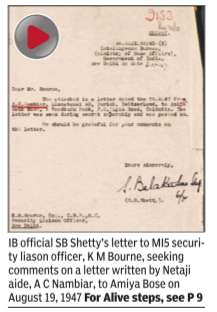
The Times of India Apr 12 2015
Documents reveal Nehru govt shared info on Netaji with MI5
Himanshi Dhawan
Not only did the Nehru government snoop on Netaji Subhas Bose but also shared confidential information with British intelligence agency MI5. Recently , declassified documents reveal India's Intelligence Bureau shared with MI5 a letter between close Netaji aide A C Nambiar and nephew Nambiar and nephew Amiya Nath Bose acquired through “secret censorship and even sought more information on the subject. The MI5 documents have become public at a time when Indian secret documents reveal that the late PM Jawarharlal Nehru had authorized surveillance on freedom fighter Netaji Bose's family including nephews Amiya Bose and Sisir Kumar Bose.
In a letter written on October 6, 1947, IB official S B Shetty sought “comments of MI5 security liaison of ficer K M Bourne posted in Delhi referencing a letter written by Nambiar to Ami ya Bose on August 19, 1947.“The attached is a letter dat ed the 19.8.47 from A C Nam biar, Limmatquai 80, Zurich, Switzerland to Amiya Nath Bose, 1 Woodburn Park, P O, Elgin Road, Calcutta. The letter was seen during secret censorship and was passed on. We should be grateful for your comments on the let ter, the note said.
In response, Bourne for warded Nambiar's letter en closing his request for fur ther information to MI5 director general the next day itself. Dated October 7, 1947, Bourne's letter says, “Any comments you may make on this letter will be appreciat ed. The letter could be about Bose's wife and daughter though the context is unclear.
Two letters, written just months after India's independence, are part of 2000 pages of MI5 declassified doc uments that were made pub lic last year. The documents were accessed by author Anuj Dhar who has spent 15 years researching Bose.
They raise serious questions about the confidentiality of Indian intelligence documents and the security establishment's doubts over Bose and his links with the Axis powers --Germany and Japan. Both nephews Amiya and Sisir, sons of Sarat Chandra Bose were on surveillance, according to the documents. Only 10,000 of the 70,000 pages of the voluminous records were made public three months earlier.
Other involved security and intelligence agencies
The Times of India Apr 12 2015
V Balachandran
IB played junior partner to MI5 well after 1947
We often think security and intelligence services are bestowed with greater intelligence than bureaucracy . Law rence J Peter of “Peter Principle“ said “Bureaucracy defends... status quo long past when quo has lost its status“. Security and intelligence establishments often follow this policy resulting in hilarious situations.Before 1947 IB was controlled by MI5, Britain's domestic intelligence service and a department called “Indian Political Intelligence“ (IPI), run by India Office, Scot land Yard and India government.
IPI, started by a lone Indian police officer in 1909 to keep vigil on revolutionaries, grew into a massive organization by World War II. By 1935, arrangements were made in all colonies integrating intelligence, police and security organizations to face freedom strug gles. From 1919, Britain considered the “Red Menace“ as their top challenge.
Our bureaucracy and IB continued that policy till 1975 when Indira Gandhi admonished them during the annual IB conference, which I attended.
After 1947 this MI5-IB liaison continued.An unwritten agreement during the transfer of power in 1947 was the secret positioning of a security liaison officer (SLO) tioning of a security liaison in New Delhi as MI5's representative. This was obtained by Guy Liddel, then deputy D-G, MI5, declassified archives say .
Normally , any intelligence liaison with an independent country should've been maintained by Britain's foreign intelligence service -MI6. But MI5 resisted such attempts till 1971. British archives quoted then IB director S P Verma writing to the MI5 chief that he didn't know “how he'd manage without a British SLO“, when told about his withdrawal.
IB followed Britain's intelligence priori ties. British archives reproduced a letter from the late T G Sanjeevi Pillai, IB's first director, on the need for liaison with MI5. Sanjeevi didn't like V K Krishna Menon, a Nehru confidante. The dislike was shared by Liddel who assured his government: “We're doing what we could to get rid of Krishna Menon“. They didn't succeed. B N Mullik, second director, continued this policy . According to British archives he “encouraged“ Walter Bell, then SLO, to visit IB's headquarters to see its work on preventing communist subversion.fied British archives speak of dis Declassified British archives speak of disconnect between Nehru's policies and IB's priorities. This was evident during the exchange visits of Soviet leaders Bulganin and Khrushchev to India and Nehru's USSR visit heralding closer Indo-Soviet ties in 1955. One year later there was a chill in Indo-UK ties when Nehru condemned the Anglo-American invasion on the Suez. This “had little impact“ on the IBMI5 collaboration. IB allowed MI5 to study its records on Moscow's subsidies to Indian communists. In 1957, Mullik wrote to Roger Hollis, MI5 chief: “...I never felt I was dealing with any organization which was not my own“.
Christopher Andrew, official MI5 historian, concludes: “Nehru either never discovered how close the relationship was or -less probably-did discover and took no action“.
This needs to be kept in mind before concluding Nehru ordered IB snooping on Netaji's family. Declassified IPI records indicate Bose was under watch since April 1924. In 1922 revolutionary Abani Mukherjee was sent by Comintern to India. Purabi Roy , Netaji's biographer says he spent 11 months in Calcutta.British intelligence must've started watch over Subhas and his family after this. A full picture will be available only if we declassify all our Bose records.
IB tailed relatives to find truth
The Times of India, Sep 25 2015
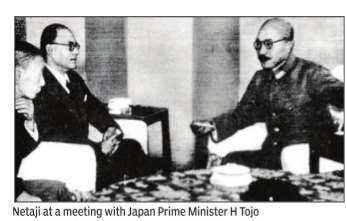
Kingshuk Nag
IB did not believe Netaji died in 1945 air crash
Snooped on kin to get info on leader's whereabouts
The Intelligence Bureau was sleuthing on relatives of Subhas Chandra Bose because they did not know about his whereabouts but were sure that he had not died in any air crash. “We knew he was not dead but were not sure where he was. We suspected he was in Soviet Union or Japan,“ a retired top official of Intelligence Bureau told TOI.
The entire operation was scripted by Bhola Nath Mullick, who was director of IB from 1948-68, the retired official revealed. He further said that Mullick had tremendous hold over the then Prime Minister Jawahar Lal Nehru and was snooping on Netaji relatives to serve the political interests of the latter.
“We were aware that if Netaji made an appearance suddenly he would have given Nehru a run for his position. This was the compelling reason why it was imperative that Netaji's whereabouts be found out. But in the end we could never find out precisely where Netaji was,“ the official said but refused to be identified. When asked why there was suspicion about Netaji's presence in Japan which had lost the World War II, the former sleuth said that this because he was last heard of officially in Japanese territory in Saigon.
For the purpose of Subhas Bose, Mullick had also taken the help of MI-5, the British intelligence agency . Copies of intelligence gathered by IB were shared with the British agency and sometimes help was taken from MI-5 to develop the leads further, the ex-IB sleuth said. In fact, an MI-5 liaison office was allowed to be operated from New Delhi. Often data about financial help given by USSR to the Communist Party and other agencies was forwarded to MI-5. London was interested in what was happening behind the Iron Curtain be cause of the Cold War that had begun almost immediately after the conclusion of the World War II.
“It was for the yeoman's service rendered to Nehru that Mullick continued in his position for two long decades. Nehru could not think of allowing him to go,“ the retired sleuth, who later served in Research and Analyses Wing (RAW), said.Incidentally , Mullick belonged to Calcutta, the same city as Subhas Bose but had cultivated an anti-Netaji sentiment because that is what worked in the Nehru regime, the official who now lives in quiet retirement told TOI.The official worked in India's intelligence outfits from the 1950s to the 1990s. Although an IPS officer, he spent his entire career in intelligence.
“We reasoned that Netaji, wherever he was, would try to get in touch with his close relatives like nephews Amiya Nath Bose and Sisir Bose.That is why their correspondence was intercepted,“ the exIB official told TOI. The interception of the mails of Bose family members was organised by the IB office in Calcutta and the head of the office was a top favourite of Mullick.
It is interesting to note that even while IB was trying to trace the whereabouts of Netaji, the Nehru government in its public utterances kept on insisting that Subhas Bose had died in the air crash.Even an official committee under Shah Nawaz Khan was set up in 1956 that insisted that Netaji had died in the air crash. The report was accepted by the government. Khan, a former INA officer, had by the time he had been appointed head of the committee become a member of the Nehru establishment and a deputy minister at the Centre.
Surveillance by the Nehru government


The Times of India Apr 12 2015
FAMILY QUESTIONS - Was Nehru privy to a Netaji secret?
Subhro Niyogi
The extraordinary surveillance that Nehru's government mounted on Netaji's kin is akin to intelligence operations against suspected terrorists, shocked Bose family members told TOI in the wake of reports from two declassified files on Subhas Chandra Bose. The Nehru government's surveillance on Netaji's relatives is akin to intelligence operations against suspected terrorists, Bose family members say . “We knew we were being watched, but had no idea it was to this degree. The lengths to which intelligence operatives went to procure information --snooping on our mail, trailing family members--shows this was no ordinary surveillance. It reveals Nehru's anxiety about the Bose clan,“ said Chandra Bose, grandson of Netaji's brother Sarat. Of Netaji's six brothers and six sisters, he was closest to elder brother Sarat.
What the family finds difficult to explain is the motive behind the surveillance. Sarat Bose's daughter Chitra Ghosh says the initial years of spying, post-Independence, could've been a colonial legacy . “It was natural to be under watch during British rule. I don't believe it continued more than two decades without special instructions. It should've ceased after my father died in 1950. It didn't.“
Dwarakanath Bose, son of Netaji's brother Sunil, says Sarat's sons Amiya and Sisir weren't even politicians when surveillance was on. “ Amiya was a barrister and Sisir a pediatrician. Amiya joined politics in 1968 when he was elected MP , Sisir in the 1980s,“ he reasoned.
Was there a Bose secret that made Nehru wary? That appears logical, the family believes. Chitra is certain Nehru knew Netaji hadn't died in the crash but he might not have known where he had gone either. “It's perhaps this desperation to know where Netaji was and the insecurity playing on his mind that led to the surveillance,“ she said.
Sugata, son of Sisir Bose who drove the car from the Elgin Road house in the first leg of Netaji's Great Escape from house arrest in 1941, has another take. “Surveillance... intensified after 1957 when father began inviting former INA members to collect material for Netaji Research Bureau. Perhaps his actions were misconstrued and led Nehru to apprehend that he was preparing to mount a political challenge,“ said Sugata, Harvard professor and now Trinamool RS MP .
What family members find devious is Nehru's apparent friendliness with the family , particularly with Sarat and his son Amiya. Nehru stayed at 1 Woodburn Park during visits to Kolkata. “In 1949, we travelled to Europe to meet INA members...In Rome we met Quorini, Italian consul in Kabul at the time of the Great Escape.He had given Subhas an Italian passport in the name of Orlando Mazzotta. We met Netaji aides ACN Nambiar and NG Swamy . When we arrived in London, Nehru was there and he exclaimed, `What's Sarat doing here?'“ Chitra recounted.
MHA was reluctant to renew Amiya's passport before his Japan visit. “There was curiosity on why he was going to Japan, whether a trip to Renkoji where Netaji's alleged ashes are kept was on the itinerary ,“ says Chandra.
Efforts of Congress to shield Nehru
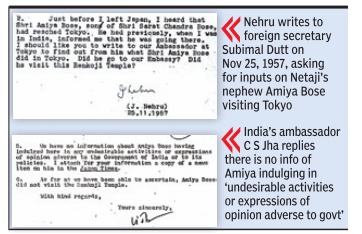
The Times of India Apr 12 2015
Himanshi Dhawan
Sought info on Bose nephew's visit to Japan
The controversy over whether the Nehru government ordered surveillance on Netaji Subhas Chan dra Bose's family seems set to escalate following disclosure that the first PM had personally sought information on their whereabouts. Documents accessed by author Anuj Dhar for his book, `India's Biggest Coverup', show that Nehru, in a let ter dated November 25, 1957 to the then foreign secretary Subimal Dutt, sought to know what Bose's nephew Amiya Nath Bose was doing in Tokyo. In response, India's ambassador to Tokyo reported back assuring New Delhi that Amiya Bose had not “in dulged in any undesirable activities. Amiya Bose, son of Subhas's brother Sarat Chandra Bose, was known to be close to Netaji.
Dhar has researched Netaji Bose for the last 15 years and has accessed rare archival material from British and Indian national archives for his book.
The revelation deals a setback to Congress's effort to buffer Nehru against the snooping charge that the Intelligence Bureau reported directly to the home minister. Documents showing that Jawaharlal Nehru had sought information on Netaji Subhas Bose's nephew Amiya Nath Bose's activities in Japan deals a setback to Congress's effort to shield the first PM from charges of snooping by claiming that the Intelligence Bureau reported directly to the home minister.
Congress spokesperson Abhishek Singhvi on Friday had alleged that the allegation that Nehru had spied on Bose's family for 20 years between 1948 to 1968 was a “systematic and sinister propaganda of selective leaks and half-truths in an attempt to tarnish the image of national icons and former home ministers like Vallabhbhai Patel, C Rajagopalachari, Lal Bahadur Shastri, Govind Ballabh Pant, Gulzarilal Nanda and others. The party has held that the IB reports to the home ministry seeking to contain the damage that the snooping was directed by Nehru himself.
“Just before I left for Japan, I heard that Shri Amiya Bose, son of Shri Sarat Chandra Bose, had reached Tokyo.He had previously , when I was in India, informed me that he was going there. I should like you to write to our Ambassador at Tokyo to find out from him what Shri Amiya Bose did in Tokyo. Did he go to our Embassy? Did he visit this Renkoji Temple? said Nehru's note to foreign secretary Dutt in November of 1957.
In response, then ambassador in Tokyo C S Jha wrote, “We have no information about Amiya Bose having indulged in any undesirable activities or expressions of opinion adverse to the Government of India or to its policies. I attach a copy of a news item on him in the Japan Times. As far as we have been able to ascertain, Amiya Bose did not visit Renkoji Temple.
Family under surveillance
Nehru govt spied on Subhash Chandra Bose's family for 20 years: Report


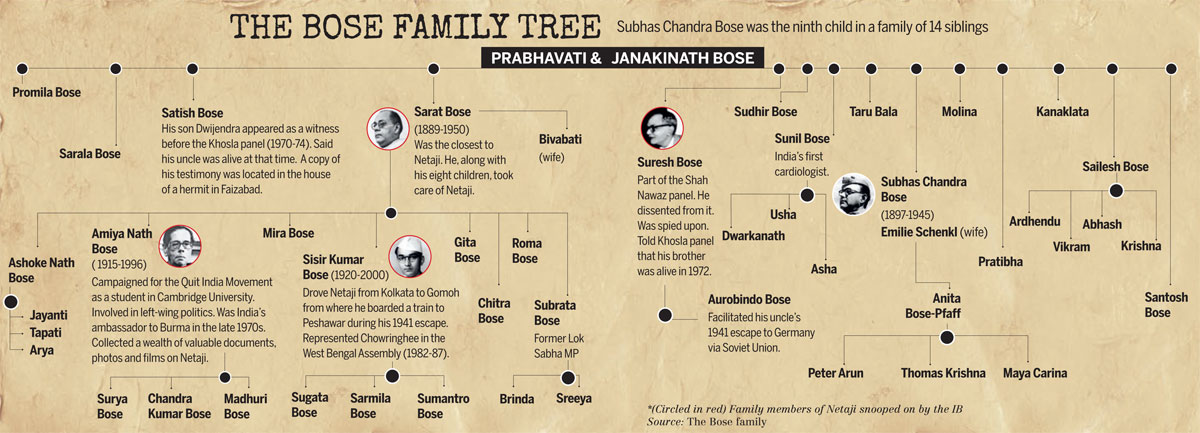
The Times of India TNN | Apr 10, 2015
NEW DELHI: The Jawaharlal Nehru government had placed the family and relatives of Subhas Chandra Bose on surveillance for two decades, Times Now reported quoting de-classified intelligence reports.
Reacting to reports, the family of Subhas Chandra Bose sought full declassification of files that revealed that the Nerhu government had placed Bose family under surveillance.
However, taking the line adopted by the previous Congress-led UPA government, Prime Minister Narendra Modi's Office has already refused to disclose records related to Subhas Chandra Bose's death as it rejected the argument that there was a larger public interest involved in making them public.
Why snoop on the family?
"Nobody has done more harm to me, than Jawaharlal Nehru," wrote Netaji in 1939, in a letter to his nephew Amiya Nath Bose. The two claimants to Mahatma Gandhi's political legacy split when he chose Nehru over Subhas Bose as his political successor because he was uncomfortable with the latter's push for complete independence. Meanwhile, Nehru was uncomfortable with Bose's admiration for Nazi Germany and Facist Italy. Finally, Netaji resigned as Congress president in 1939. Historian Rudrangshu Mukherjee's 2014 book Nehru & Bose: Parallel Lives states that "Bose believed he and Jawaharlal could make history. But Jawaharlal could not see his destiny without Gandhi, and the latter had no room for Subhas".
Netaji however bore Nehru, eight years his senior, no ill will. He considered him an older brother and even named one of the INA regiments after him. Nehru publicly wept when he learned of Subhas Bose's death in 1945.
Why then would the Nehru government place the Bose family under such rigorous surveillance? Especially given Nehru's dislike of the cloak-and-dagger work. Former IB chief B.N. Mullick says in his 1971 book My Years With Nehru that the PM "had such a moral aversion to this work (espionage) that he would not allow us to operate even against the offending country's intelligence groups operating from the shelter of their diplomatic offices in India".
Nehru was the PM for 16 of the 20 years of the snooping. "There is only one reasonable explanation for this long surveillance on the Bose family by IB, which reported directly to Nehru," says BJP national spokesperson and author M.J. Akbar. "The government was not sure that Bose was dead, and thought that if he was alive, he would be in some form of communication with his family in Kolkata. Why would Congress be apprehensive about this? Bose was the only charismatic leader who could have mobilised opposition unity against the Congress, and offer a serious challenge in the 1957 elections. It is safe to say that if Bose were alive, the coalition that defeated the Congress in 1977 would have trounced Congress in the 1962 General Election, or 15 years earlier," he says.
The only documentary evidence that Nehru wanted to know what the Bose family was up to comes in a confidential November 26, 1957, letter the PM wrote to then foreign secretary Subimal Dutt. "Just before I left Japan, I heard that Shri Amiya Bose, son of Shri Sarat Chandra Bose, had reached Tokyo. He had, previously, when I was in India, informed me that he was going there. I should (sic) like you to write to our ambassador at Tokyo to find out from him what Shri Amiya Bose did in Tokyo. Did he go to our Embassy? Did he visit this Renkoji Temple?" The ambassador replied in the negative.
The Bose family's international itineraries, correspondence with German and Japanese officials and their travels through India meeting Netaji's former associates, led the IB to fear a resurrection of the INA. In one 1949 letter, Amiya Bose asks Sisir Bose, then a medical student in London, to find out whether any of the German generals were once again active in West Germany, particularly Hitler's former chief of staff General Franz Halder.
"There is clearly an element of government paranoia here," says Krishna Bose. "My husband was only trying to gather material to set up the Netaji Research Foundation. This foundation was set up only through correspondence." The IB however believed otherwise. A 'Top Secret' note from 1968 flags Amiya Bose. "The subject is now reportedly taking keen initiative in the formation of the Azad Hind Dal with ex-INA men. It is reported that he has succeeded in influencing some prominent persons both in the state and the Centre."
V. Balachandran, former RAW special secretary, believes the Bose fa mi ly was kept under surveillance because of their communist leanings. He points to the diaries of Guy Liddell, who headed MI5's counter-espionage wing during World War II. Published in 2012, they mention the British internal security service's umbilical ties with the IB. Monitoring communists was a priority for MI5, a legacy it passed on to the IB. During a visit to India in March 1947, Liddell claimed to have obtained the Nehru government's clearance for an MI5 security liaison officer to be stationed in New Delhi after the end of British rule. "The IB's obsession with tailing communists continued until Mrs Gandhi ended it in 1975," Balachandran says.
Spying on Netaji’s kin
The Times of India, Sep 19 2015
Revealed: Shocking scale of snooping on Netaji kin
After Independence, 14 intelligence officers snooped on two Bose family residences.Agents tracked every move of the members and opened all mail posted from or arrived at the twin addresses on Elgin Road and Woodburn Park. These surveillance reports, and those from the early 1940s, are compiled in 13 of the 64 files made public on September 18, 2015. It is shocking to see the amount of manpower and time devoted to spy on relatives of one of India's greatest sons, say Netaji followers. Even the letter Emelie Schenkl wrote to Sarat Bose, disclosing her relationship with Netaji and the presence of a child, was intercepted.
“I cannot believe the operation was so big.It's incredible that so much resource was put into tracking the family even after Independence. The surveillance wasn't half as strong during British rule. It has now emerged that several files were maintained on Netaji's elder brother Sarat Bose and every move that his sons Amiya Nath and Sisir made was tracked,“ said Amiya Nath's son Chandra.
The extraordinary surveillance spanning two decades left Netaji's kin shell-shocked when two files were made public in April 2015. Now, with more files emerging from the lockers, the family is stunned. Apart from two files on Amiya Nath and Sisir, there are eight files on Sarat Bose and one on contacts of the Bose family with the Japan consulate.
The family wonders why such a huge operation was mounted if the Centre believed Netaji had died in Taihoku. “Such operations are mounted against terrorists, not citizens and patriots. We were aware of the snooping but the scale of the operation takes my breath away .This reveals Jawaharlal Nehru's anxiety about the Bose family,“ said Chandra.
Sarat Bose's daughter Chitra is aware of Nehru's involvement in the snooping.“There's no reason why the state government would spend so much resource unless there was a diktat from the Centre. I believed Nehru and my father were on good terms,“ said Chitra.
Chitra believes Nehru was wary because he knew the crash was a hoax and feared Netaji was confabulating with his family from abroad.“Insecurity played on Nehru's mind,“ she said.
“The leaders behind the (snooping) move should be exposed. I demand an inquiry into why citizens of an independent country were put under surveillance,“ says Chandra.
Spying on Sisir and Amiya
The Times of India, Sep 19 2015
Rakhi Chakrabarty
Sisir, a reputed Kolkata paediatrician, drove the car Netaji used to escape from his Elgin Road house in 1940. Amiya, also a noted physician, participated in the Quit India Movement, became an MP and was the Indian ambassador to Myanmar.
Decades after independence, intelligence units of Bengal and the Centre's Intelligence Bureau were intercepting letters exchanged between Bose family members. Every move, especially of Sisir and Amiya were tracked by “agents“.
The declassified files contain letters and “secret weekly surveys“ of “activities“ of Bose family members up to the 1970s when Congress ruled Bengal and Siddharth Shankar Ray was CM.
IB too sought regular reports on the Bose family . One file show that on August 20, 1971 Delhi wrote to Bengal's intelligence branch asking “if there's anything adverse against Sisir Bose“. A veteran intelligence officer said: “These days, I don't think we track even criminals or terrorists like this.“
The weekly survey of the Calcutta Police security control for week ending August 26, 1965, includes a letter Sisir wrote to Tatsuo Hayashida seeking specific information on Netaji in Japan. Sisir wrote: “The Netaji Inquiry commission made a great mis take by not visiting Formosa and holding an investigation on the spot. Moreover, there was no judicial per son on the said com mittee.“